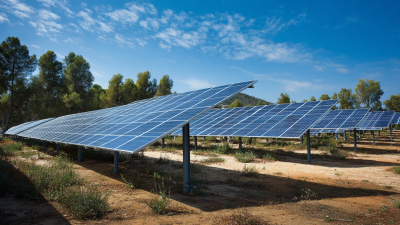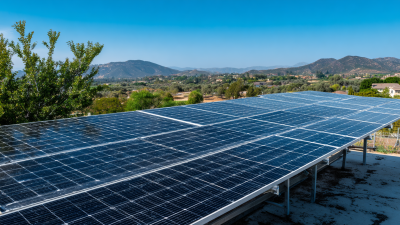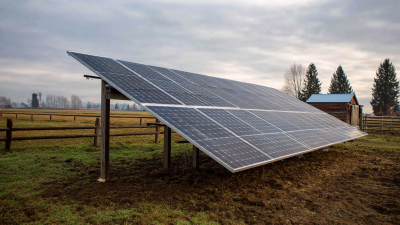Blog
Essential Checklist for Installing Roof Solar Panels to Maximize Energy Efficiency
As the demand for renewable energy sources continues to rise, many homeowners are turning to roof solar panels as a viable solution to reduce their carbon footprint and energy costs. According to the Solar Energy Industries Association, the U.S. solar market has grown by over 167% in the past five years, showcasing the increasing reliance on solar energy as a sustainable alternative.

However, to truly maximize the energy efficiency of roof solar panels, careful planning and installation are essential. A comprehensive checklist can guide homeowners through this critical process, ensuring that they make informed decisions that enhance their system's output while capitalizing on available incentives. By understanding the key factors involved—from site assessment to proper equipment selection—homeowners can tap into the full potential of their roof solar panels, contributing to both environmental sustainability and long-term savings.
Key Factors to Consider Before Installing Solar Panels on Your Roof
When considering the installation of roof solar panels, homeowners must evaluate several key factors to ensure maximum energy efficiency. One of the most crucial aspects is the type of solar panels chosen. Recent market trends show an increasing interest in frameless solar panels, which are lauded for their sleek design and improved aesthetic appeal over traditional framed options. With the global dye-sensitized solar cell market projected to expand significantly by 2025, homeowners should stay informed about emerging technologies that could enhance energy capture and efficiency.
Additionally, understanding the financial investment required is vital. According to industry reports, the average cost of installing a solar energy system in the U.S. can vary widely based on location and system size, but projections indicate that these costs will stabilize over the coming years. This trend highlights the importance of thorough cost-benefit analyses before making a commitment. As solar panel prices in markets like Australia fluctuate, it becomes necessary for homeowners to strategize the timing of their investments carefully.
Investing in solar panels not only contributes to a reduction in carbon emissions but also enables homeowners to harness energy storage solutions for backup during outages. With legislation, such as the upcoming requirement in Tokyo for new residential buildings to include solar systems, the push for sustainable energy solutions is intensifying; thus, conducting comprehensive research prior to installation is essential for maximizing long-term benefits.
Essential Checklist for Installing Roof Solar Panels to Maximize Energy Efficiency
| Factor | Description | Importance Level |
|---|---|---|
| Roof Condition | Ensure the roof is structurally sound and capable of supporting solar panels. | High |
| Orientation | Position panels to face true south for optimal sunlight exposure. | High |
| Tilt Angle | Install panels at an angle that maximizes sunlight absorption based on your geographic location. | Medium |
| Shading Analysis | Assess potential shading from trees, buildings, or other obstructions. | High |
| System Size | Determine the appropriate size of the solar system based on energy needs and roof space. | High |
| Local Regulations | Check zoning laws, permits, and homeowner association guidelines. | Medium |
| Inverter Type | Choose between string inverters, microinverters, or power optimizers for efficiency. | Medium |
| Financial Incentives | Research available tax credits, rebates, and financing options. | High |
Top Solar Panel Options: How to Choose the Right Types for Your Home
Choosing the right type of solar panel for your home is a crucial step in maximizing energy efficiency. When evaluating your options, consider the three main types of solar panels: monocrystalline, polycrystalline, and thin-film. Monocrystalline panels are known for their high efficiency and longevity, making them an excellent choice for homeowners with limited roof space. Their sleek appearance and greater energy output per square foot can significantly bolster energy savings, especially in urban settings.
Polycrystalline panels, on the other hand, offer a cost-effective solution with decent efficiency. These panels are made from multiple silicon crystals, which results in a lower manufacturing cost and ultimately a lower price for consumers. While they may take up more space compared to monocrystalline options, they can still effectively meet the energy needs of most households. Additionally, thin-film solar panels are gaining popularity due to their lightweight and flexible design, allowing installation on a variety of surfaces. However, they typically have lower efficiency rates and may require more space to produce the same energy output as the other two types. In conclusion, understanding these options will empower you to choose the most suitable solar panels for your specific energy needs and roof characteristics.
Evaluating Your Roof: Structural Integrity and Sunlight Exposure Analysis
When considering the installation of roof solar panels, evaluating your roof's structural integrity and sunlight exposure is paramount. A robust roof can support the additional weight of solar panel systems, which typically average 40 pounds per panel. According to the National Renewable Energy Laboratory, roofs must not only be structurally sound but also have an appropriate slope and orientation for optimal solar energy capture. Ideally, roofs facing south with a tilt of 30-45 degrees maximize sunlight exposure, allowing systems to harness up to 200% more energy compared to those with a less favorable orientation.
Furthermore, assessing sunlight exposure is crucial for maximizing energy efficiency. A study by the Solar Energy Industries Association reveals that even slight obstructions, like trees or chimneys, can reduce solar energy production by 10-20%. Using tools like solar pathfinders or shading analysis software can accurately determine how shadows move across your roof throughout the day and seasons, helping to identify the best placement for solar panels. This careful analysis not only enhances energy efficiency but also ensures a better return on investment, with potential savings on energy bills reported to be as high as 75% in optimal scenarios.

Understanding Local Regulations and Permits for Solar Panel Installation
When considering solar panel installation, understanding local regulations and obtaining the necessary permits is crucial. Different states and municipalities have varying rules that can affect the installation process and the potential savings. According to a report by the Solar Energy Industries Association (SEIA), approximately
30% of solar installation costs are linked to local compliance and permitting fees. Therefore, being informed can save both
time and money during your solar journey.
Tip: Always check with your local government or a trusted solar installer to get a copy of the current regulations and permitting requirements in your area. This will help you identify any specific standards or restrictions that could impact your project.
In addition, zoning laws may regulate the placement and aesthetics of solar panels. Some jurisdictions may have restrictions on roof-mounted systems, especially in historic districts or neighborhoods with stringent design guidelines. In fact, a study from the National Renewable Energy Laboratory (NREL) found that clearer regulations lead to a significant increase in solar adoption, hinting that navigating rules accurately can open the door to potential incentives and smoother installations.
Tip: Consider attending local workshops or information sessions focused on solar energy. These events often provide valuable insights into regulations and can connect you with experienced professionals in your community.
Maintenance Tips for Ensuring Long-Term Efficiency of Your Solar System
When it comes to maintaining the long-term efficiency of your solar system, regular maintenance should be your top priority. One of the most critical tasks is to keep the solar panels clean. Dust, debris, and bird droppings can accumulate over time, reducing the panels' ability to absorb sunlight effectively. A simple solution is to wash the panels periodically with a soft brush and soapy water, or you can hire professional cleaning services to ensure a thorough job without damaging the delicate surface.

In addition to cleaning, it is essential to inspect your solar system for any signs of wear or damage. Regularly check for loose connections, frayed wires, or any shading from nearby trees that could impede performance. Furthermore, monitor the system's output using a solar monitor to detect any sudden drop in energy production, which can indicate issues that need to be addressed promptly. By staying proactive with maintenance and monitoring, you can extend the life of your solar panels and continue to enjoy the benefits of renewable energy for years to come.
Related Posts
-

How to Choose the Best Free Solar Panels for Your Business: A Comprehensive Guide
-

Emerging Trends in Solar Energy for the Best Solar Panels by 2025
-

The Future of Sustainable Living with DIY Solar Systems
-

Challenges Faced with 400 Watt Solar Panel Installation
-

How to Choose the Right Off Grid Solar System for Your Home
-

10 Remarkable Reasons to Choose a Solar Panel System for Your Home

